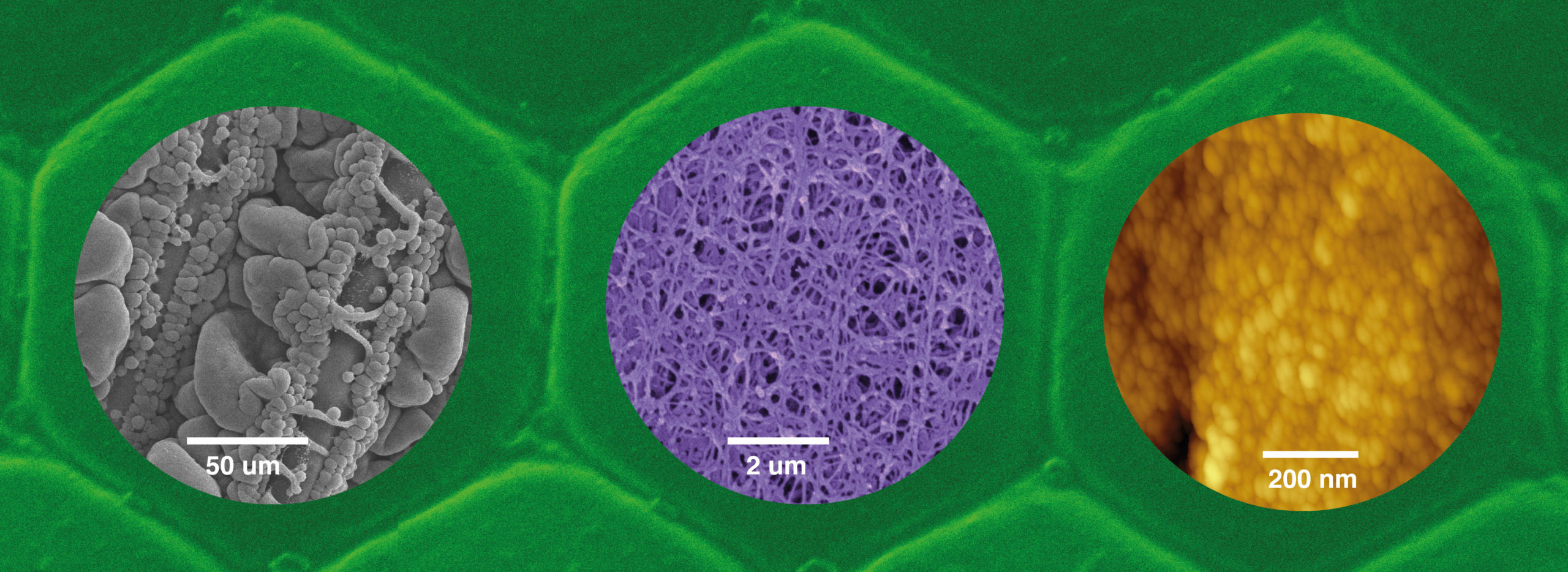
Green Chemistry & Nanotechnology
Green Chemistry is concerned with environmentally friendly production and application of chemistry. The focus is on environmentally friendly production steps, such as saving water and energy or switching to water-based coatings. From these approaches, we derive new products for environmental protection, for increasing resource efficiency or new recycling strategies. Topics at DTNW are new halogen-free and thus environmentally friendly flame retardants, textile-based adsorber systems* for environmental protection (groundwater remediation, removal of micro pollutants) or for the recovery of resources from manufacturing processes or urban mining/textile mining.
Another important topic is new green approaches for antibacterial or antifouling finishes, which do not require classic biocides that have to be released for application, such as silver or quaternary ammonium groups.
The Green Chemistry topic area also deals with the topic area of light and how fluorine-free, self-cleaning surfaces can be created with the help of light. Or how to equip textiles in such a way that they enable heat reflection, so that less heating takes place under a textile construction, or the heat remains in a tent, for example.
*There is close cooperation between the Mayer-Gall working group and the Opwis working group on the topic of textile-based adsorber systems and flame protection.
Nanotechnology is concerned with changing familiar properties when the size of materials is reduced to just a few nanometres. This can, for example, extremely increase the catalytic efficiency of a material or lead to the properties of a composite improving. The DTNW deals with possibilities that arise from the consistent application of nanotechnology for the functionalisation of textiles, for example when it comes to improving abrasion resistance, achieving antistatic properties or the resistance of a textile in aggressive atmospheres. The topic of nanotechnology also includes the topic of nanofibres and new materials for energy storage, which is being researched in close cooperation with the AG Wego.
Our research focuses:
- Synthesis and production of functional nanoparticles
- Nanofibre through electrospinning
- Nanoglass fibre
- Nano carbon fibre
- Nanosilk
- Nanofibres through defibrillation of fibre polymers
- Inorganic-organic hybrid polymers (production of hybrid materials with organic and inorganic domains with new properties)
- Light-active textiles (e.g. IR reflection & passive radiation cooling, UV protection, self-cleaning textiles, antibacterial effect)
- Green flame retardant (development of halogen-free flame retardants):
- Textiles
- Fibre-reinforced composites
- Wood
- Wood-Plastic-Composites (WPC), cable sheathing, electronic enclosures (E&E)
- Transparent polymers
- 3D printing
- Textile-based adsorber systems
- PFT/PFC
- Nitrate/phosphate
- Micro pollutants (pharmaceuticals, pesticides etc.)
- Novel detector systems for organometallics in the environment
- Textile recycling
Within the Green Chemistry & Nanotechnolgy WG, Master’s, Bachelor’s and internship theses of the:
- University of Duisburg-Essen
- Niederrhein University of Applied Sciences (Krefeld Campus (Chemistry) & Mönchengladbach Campus)
- Rhine-Waal University of Applied Sciences (Kamp-Lintfort Campus)
- Hamm-Lippstadt University of Applied Sciences (Lippstadt Campus)
supervised.
The working group cooperates with different project partner all over Germany:
UDE, IUTA, HSHL, HSB, TU Dortmund, WKI, KIMW
Head of the working group
Dr Thomas Mayer-Gall
Tel.: +49-2151-843-2015
e-Mail: mayer-gall@dtnw.de
Scientific staff of the AG Mayer-Gall
Dr Wael Ali
Flame retardants and nanofibres
Tel.: +49-2151 843-2028
Tel: +49-201 183-3047
e-Mail: ali@dtnw.de
Dr Alaa Salma
Textile-based adsorber systems
e-Mail: salma@dtnw.de
Omid Etemad-Parishanzade
Antibacterial or -fouling surfaces and IR-reflective coatings
e-Mail: Etemad-Parishanzade@dtnw.de
Dr Dominic Danielsiek
Smoke suppressing finishes for textiles
e-Mail: Danielsiek@dtnw.de
PhD students
Valbone Shabani
Flame retardants as polymer additives
e-Mail: Shabani@dtnw.de
Master’s students
Fabian Schäfer (UDE)
Harini Hemesh (UDE)
Bachelor students
Ana Raquel Lema Jimenez (HSNR)
Laura Chromik (HSNR)
Flame retardancy and smoke suppression properties of novel phosphorus, nitrogen, silane and organoboron hybrid material for cellulosic fabrics.
Alumni
| Ph.D Students | |
| Dr. Thomas Straube | Dissertation AZO nanoparticles |
| University of Duisburg-Essen | |
| Ana Marija Topalvic | Advanced Studies |
| Anna Rabe | Advanced Studies |
| Dana Lauer | Bachelor & Master’s thesis |
| Dennis Killa | Master’s thesis |
| Dennis Wippler | Master’s thesis |
| Didem Ibas | Master’s thesis |
| Franziska Elisa Wichmann | Master’s thesis |
| Juliane Schoening | Analytical Studies |
| Matthias Linke | Analytical Studies |
| Marcel Plonowski | Bachelor thesis |
| Mohamed Salam | Bachelor thesis |
| Mustafa Cetin | Master’s thesis |
| Nirtharsan Paransothy | Master’s thesis |
| Pia Nelder | Bachelor thesis |
| Rabia Mutlu | Advanced Studies |
| Raphael Otto | Master’s thesis |
| Seden Caglar | Advanced Studies & Master’s Thesis |
| Swetlana Ziegenhagel | Advanced Studies |
| Ying Feng | Advanced Studies, Master’s thesis |
| Yuteng Zhang | Analytical Studies |
| University of Applied Sience Niederrhein | |
| Olga Zilke | Master’s thesis |
| Samitha Amaradasa | Master’s thesis |
| Nadine Köpke | Intership |
| Malte Prell | Bachelor thesis |
| University of Applied Sience Rhein-Waal | |
| Rajshree Jeewon | Intership |
| Hung Ming Phan | Bachelor thesis |
| Yuze Wu | Bachlor thesis |
| Rizky-Prandityasa Putratama | Intership |
| University of Applied Sience Hamm-Lippstadt | |
| Alina Heß | Advanced Studies |
| Exchange programs | |
| Fawzy Sherif | University Menufiya, Egypt |
| Zahid Zawar | Kaunas University of Technology, Litunania now National Textile University, Pakistan |
| Muhammad Usman Munir | Kaunas University of Technology, Litunania |
